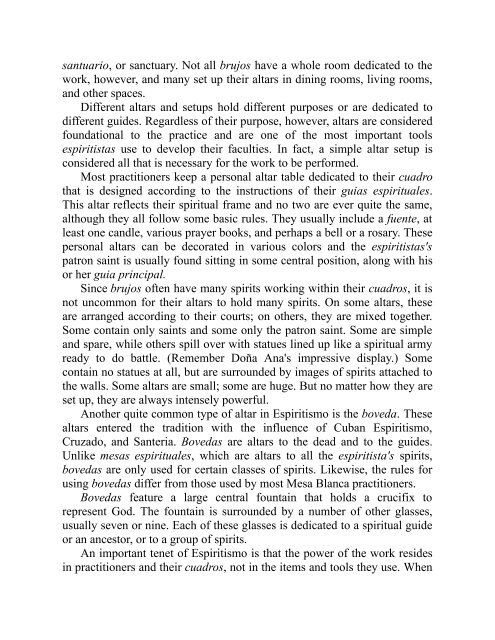You also want an ePaper? Increase the reach of your titles
YUMPU automatically turns print PDFs into web optimized ePapers that Google loves.
santuario, or sanctuary. Not all brujos have a whole room dedicated to the<br />
work, however, and many set up their altars in dining rooms, living rooms,<br />
and other spaces.<br />
Different altars and setups hold different purposes or are dedicated to<br />
different guides. Regardless of their purpose, however, altars are considered<br />
foundational to the practice and are one of the most important tools<br />
espiritistas use to develop their faculties. In fact, a simple altar setup is<br />
considered all that is necessary for the work to be performed.<br />
Most practitioners keep a personal altar table dedicated to their cuadro<br />
that is designed according to the instructions of their guias espirituales.<br />
This altar reflects their spiritual frame and no two are ever quite the same,<br />
although they all follow some basic rules. They usually include a fuente, at<br />
least one candle, various prayer books, and perhaps a bell or a rosary. These<br />
personal altars can be decorated in various colors and the espiritistas's<br />
patron saint is usually found sitting in some central position, along with his<br />
or her guia principal.<br />
Since brujos often have many spirits working within their cuadros, it is<br />
not uncommon for their altars to hold many spirits. On some altars, these<br />
are arranged according to their courts; on others, they are mixed together.<br />
Some contain only saints and some only the patron saint. Some are simple<br />
and spare, while others spill over with statues lined up like a spiritual army<br />
ready to do battle. (Remember Doña Ana's impressive display.) Some<br />
contain no statues at all, but are surrounded by images of spirits attached to<br />
the walls. Some altars are small; some are huge. But no matter how they are<br />
set up, they are always intensely powerful.<br />
Another quite common type of altar in <strong>Espiritismo</strong> is the boveda. These<br />
altars entered the tradition with the influence of Cuban <strong>Espiritismo</strong>,<br />
Cruzado, and Santeria. Bovedas are altars to the dead and to the guides.<br />
Unlike mesas espirituales, which are altars to all the espiritista's spirits,<br />
bovedas are only used for certain classes of spirits. Likewise, the rules for<br />
using bovedas differ from those used by most Mesa Blanca practitioners.<br />
Bovedas feature a large central fountain that holds a crucifix to<br />
represent God. The fountain is surrounded by a number of other glasses,<br />
usually seven or nine. Each of these glasses is dedicated to a spiritual guide<br />
or an ancestor, or to a group of spirits.<br />
An important tenet of <strong>Espiritismo</strong> is that the power of the work resides<br />
in practitioners and their cuadros, not in the items and tools they use. When


















